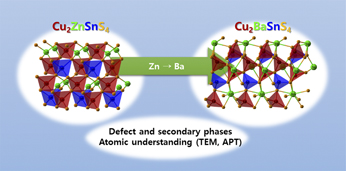Article contents
Atomistic consideration of earth-abundant chalcogenide materials for photovoltaics: Kesterite and beyond
Published online by Cambridge University Press: 12 October 2018
Abstract

Despite the potential as a promising alternative to CdTe and Cu(In,Ga)Se2, the kesterite compound Cu2ZnSn(S,Se)4 (CZTSSe) presents a critical challenge mainly from its high open-circuit voltage (Voc) deficit. Indeed, the Voc of the record CZTSSe solar cell to date has accounted for only 61% of that calculated by the Shockley–Queisser limit, whose origin can be ascribed to nonradiative recombination from a high density of defects and secondary phases. Therefore, an atomistic understanding and characterization of CZTSSe is highly essential to overcoming the current shortcomings in kesterite. This review discusses the advanced characterization techniques for studying the intrinsic properties of kesterite at a nanometer scale. Moreover, a cation substitution with an ionic mismatch around constituents is recognized as an effective route to address the fundamental limit (i.e., the cationic disorder) in CZTSSe. Here, we review recent studies on a novel chalcogenide Cu2BaSn(S,Se)4 that substitutes Zn with Ba and results in less cationic disordering.
- Type
- Invited Feature Paper - REVIEW
- Information
- Copyright
- Copyright © Materials Research Society 2018
Footnotes
This author was an editor of this journal during the review and decision stage. For the JMR policy on review and publication of manuscripts authored by editors, please refer to http://www.mrs.org/editor-manuscripts/.
This paper has been selected as an Invited Feature Paper.
References
REFERENCES
- 7
- Cited by


